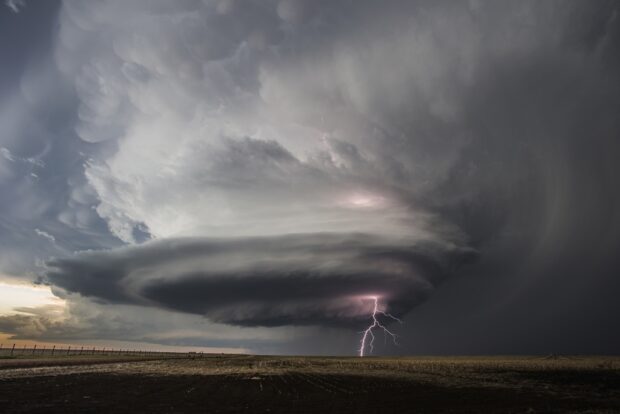U.S. severe convective storms (SCS) continued to drive global natural catastrophe losses during the first half of 2024. Of the estimated $61 billion in global H1 insured losses from natural disasters, U.S. SCS accounted for a minimum $37 billion – or 61 percent of the total, according to a Gallagher Re report.
Gallagher Re estimates that H1 2024 saw the second costliest U.S. insured SCS total on record for a first half, coming in behind 2023’s H1 total of $47 billion.
Another SCS record was broken during the past 18 months (or full-year 2023 through the first half of 2024), when insured losses surpassed $100 billion, which was the costliest two-year stretch ever recorded for the peril, said the report, titled “Natural Catastrophe and Climate Report: H1 2024.” (SCS is an umbrella term for a range of hazards including tornadic and straight-line winds, as well as large hailstones, according to Swiss Re).
“Surpassing $100 billion in insured losses within an 18-month span confirms that SCS should no longer be treated as a non-peak peril for the industry,” commented Gallagher Re Chief Science Officer Steve Bowen in a statement.
There were at least 19 individual billion-dollar insured loss events during the first half, marking the second highest H1 total on record, behind the 20 seen in 2023 and 2022, said the report, noting that 12 of those events resulted in a multibillion-dollar loss.
This elevated level of SCS activity has continued to put tremendous strain on primary insurers that are increasingly forced to absorb most, or all, of their claims payouts given the small portion of losses ceded to reinsurance, said a press release accompanying the report.
“With the reduction in aggregate coverage availability from reinsurance or the high cost to obtain such coverage, this has resulted in increased direct loss costs for insurers that have eroded underwriting performance and quarterly earnings,” the report said.
The economic costs during H1 of global natural catastrophes – an estimated minimum of US$128 billion – was slightly lower than the most recent 10-year H1 average of US$133 billion. (Economic losses include both insured and uninsured losses.)
In total, there were at least 32 individual billion-dollar economic loss events in H1, which was above the decadal average of 27, the report said, noting that 20 of those events were in the U.S. (14 of which were from SCS outbreaks).
Key takeaways from H1 2024:
- This was the sixth consecutive H1 with weather/climate-related economic losses at or above US$100 billion.
- Insurers covered at least US$57 billion, which was 22 percent higher than the decadal average of $46 billion.
- El Niño is dissipating, with La Niña expected to arrive in Q3 2024.
- H1 2024 was the warmest H1 since official record keeping began in 1850.
- Formed at the end of June, Hurricane Beryl became the first Category 5 hurricane ever recorded prior to Aug. 1. This raises concerns for the rest of the season, especially since record warm temperatures and the transition to La Niña are expected to drive an active hurricane forecast.
Photograph: This May 21, 2020, photo shows a tornado in Moscow, Kansas. (Victor Gensini via AP)





















 HOA Secures $2.5M ‘Wildfire Resilience Insurance’: WTW
HOA Secures $2.5M ‘Wildfire Resilience Insurance’: WTW  State Farm Wins Dismissal of Homeowners’ Class Action Over Use of Xactimate Software
State Farm Wins Dismissal of Homeowners’ Class Action Over Use of Xactimate Software  Performance Review: Why Insurers Struggle to Underwrite, Price and Reserve for Commercial Auto Risks
Performance Review: Why Insurers Struggle to Underwrite, Price and Reserve for Commercial Auto Risks  Revisiting California’s Wildfires: A Personal Journey
Revisiting California’s Wildfires: A Personal Journey 